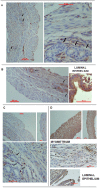Progesterone is essential for protecting against LPS-induced pregnancy loss. LIF as a potential mediator of the anti-inflammatory effect of progesterone
- PMID: 23409146
- PMCID: PMC3567061
- DOI: 10.1371/journal.pone.0056161
Progesterone is essential for protecting against LPS-induced pregnancy loss. LIF as a potential mediator of the anti-inflammatory effect of progesterone
Abstract
Lipopolysaccharide (LPS) administration to mice on day 7 of gestation led to 100% embryonic resorption after 24 h. In this model, nitric oxide is fundamental for the resorption process. Progesterone may be responsible, at least in part, for a Th2 switch in the feto-maternal interface, inducing active immune tolerance against fetal antigens. Th2 cells promote the development of T cells, producing leukemia inhibitory factor (LIF), which seems to be important due to its immunomodulatory action during early pregnancy. Our aim was to evaluate the involvement of progesterone in the mechanism of LPS-induced embryonic resorption, and whether LIF can mediate hormonal action. Using in vivo and in vitro models, we provide evidence that circulating progesterone is an important component of the process by which infection causes embryonic resorption in mice. Also, LIF seems to be a mediator of the progesterone effect under inflammatory conditions. We found that serum progesterone fell to very low levels after 24 h of LPS exposure. Moreover, progesterone supplementation prevented embryonic resorption and LPS-induced increase of uterine nitric oxide levels in vivo. Results show that LPS diminished the expression of the nuclear progesterone receptor in the uterus after 6 and 12 h of treatment. We investigated the expression of LIF in uterine tissue from pregnant mice and found that progesterone up-regulates LIF mRNA expression in vitro. We observed that LIF was able to modulate the levels of nitric oxide induced by LPS in vitro, suggesting that it could be a potential mediator of the inflammatory action of progesterone. Our observations support the view that progesterone plays a critical role in a successful pregnancy as an anti-inflammatory agent, and that it could have possible therapeutic applications in the prevention of early reproductive failure associated with inflammatory disorders.
Conflict of interest statement
Figures








Similar articles
-
Down-regulation of uterine LIF expression induced by the hormonal level disorder causes embryo implantation loss after mice exposed to carbon disulfide at peri-implantation.Biochem Biophys Res Commun. 2015 Nov 6;467(1):7-13. doi: 10.1016/j.bbrc.2015.09.141. Epub 2015 Sep 30. Biochem Biophys Res Commun. 2015. PMID: 26427868
-
Progesterone modulates the LPS-induced nitric oxide production by a progesterone-receptor independent mechanism.Eur J Pharmacol. 2015 Dec 15;769:110-6. doi: 10.1016/j.ejphar.2015.11.005. Epub 2015 Nov 5. Eur J Pharmacol. 2015. PMID: 26548622
-
Lipopolysaccharide-induced murine embryonic resorption involves nitric oxide-mediated inhibition of the NAD+-dependent 15-hydroxyprostaglandin dehydrogenase.Reproduction. 2012 Oct;144(4):447-54. doi: 10.1530/REP-12-0186. Epub 2012 Jul 27. Reproduction. 2012. PMID: 22843771
-
The fundamental role of increased production of nitric oxide in lipopolysaccharide-induced embryonic resorption in mice.Reproduction. 2003 Jan;125(1):95-110. doi: 10.1530/rep.0.1250095. Reproduction. 2003. PMID: 12622700
-
Progesterone inhibitory role on gastrointestinal motility.Physiol Res. 2022 Apr 30;71(2):193-198. doi: 10.33549/physiolres.934824. Epub 2022 Mar 28. Physiol Res. 2022. PMID: 35344673 Free PMC article. Review.
Cited by
-
The Kynurenine Pathway and Polycystic Ovary Syndrome: Inflammation as a Common Denominator.Int J Tryptophan Res. 2022 May 21;15:11786469221099214. doi: 10.1177/11786469221099214. eCollection 2022. Int J Tryptophan Res. 2022. PMID: 35620306 Free PMC article. Review.
-
Transcriptome, Spliceosome and Editome Expression Patterns of the Porcine Endometrium in Response to a Single Subclinical Dose of Salmonella Enteritidis Lipopolysaccharide.Int J Mol Sci. 2020 Jun 13;21(12):4217. doi: 10.3390/ijms21124217. Int J Mol Sci. 2020. PMID: 32545766 Free PMC article.
-
Endogenous TWEAK is critical for regulating the function of mouse uterine natural killer cells in an immunological model of pregnancy loss.Immunology. 2016 May;148(1):70-82. doi: 10.1111/imm.12588. Epub 2016 Mar 2. Immunology. 2016. PMID: 27040357 Free PMC article.
-
Significant roles played by interleukin-10 in outcome of pregnancy.Iran J Basic Med Sci. 2016 Feb;19(2):119-24. Iran J Basic Med Sci. 2016. PMID: 27081455 Free PMC article. Review.
-
Potential mechanisms and therapeutic strategies for LPS-associated female fertility decline.J Assist Reprod Genet. 2024 Oct;41(10):2739-2758. doi: 10.1007/s10815-024-03226-2. Epub 2024 Aug 21. J Assist Reprod Genet. 2024. PMID: 39167249 Review.
References
-
- Friebe A, Arck P (2008) Causes for spontaneous abortion: what the bugs ‘gut’ to do with it?. Int J Biochem Cell Biol 40: 2348–52. - PubMed
-
- Xu DX, Wang H, Zhao L, Ning H, Chen YH, et al. (2007) Effects of low-dose lipopolysaccharide (LPS) pretreatment on LPS-induced intra-uterine fetal death and preterm labor. Toxicology 234(3): 167–75. - PubMed
-
- Ogando DG, Paz D, Cella M, Franchi AM (2003) The fundamental role of increased production of nitric oxide in lipopolysaccharide-induced embryonic resorption in mice. Reproduction 125: 95–110. - PubMed
-
- Olson NC, Hellyer PW, Dodam JR (1995) Mediators and vascular effects in response to endotoxin. Br Vet J 151: 489–522. - PubMed
Publication types
MeSH terms
Substances
LinkOut - more resources
Full Text Sources
Other Literature Sources
Research Materials

